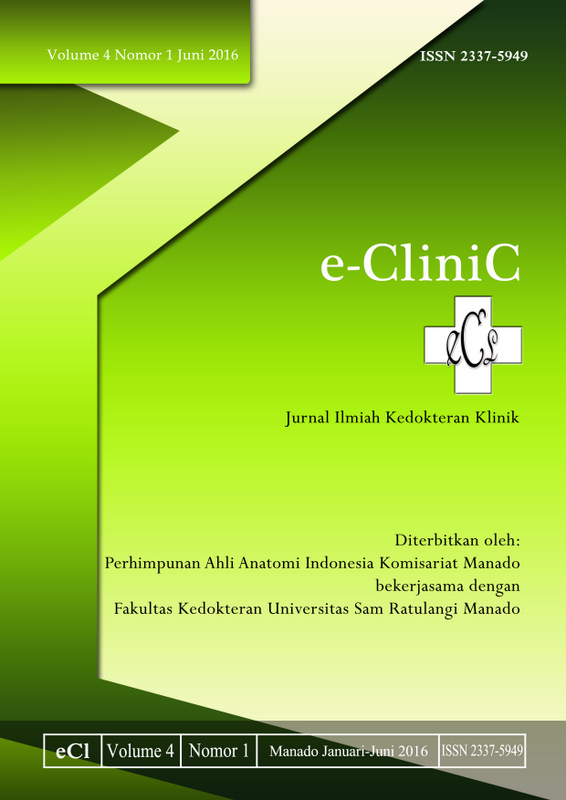Komorbiditas pada anak gangguan pemusatan perhatian dan hiperaktivitas (GPPH) pada 20 Sekolah Dasar di Kota Manado
DOI:
https://doi.org/10.35790/ecl.v4i1.11009Abstract
Abstract: Attention deficit and hyperactivity disorder (ADHD) is one of the main problems in psychiatry which is often found in children under age of 7 years. ADHD is associated with comorbidities which are: oppositional defiant disorder, conduction disorder, anxiety disorder, depression, and learning disability. This study was aimed to determine the comorbidities in ADHD children. This was a descriptive-quantitative study with a cross sectional design conducted 20 elementary schools in Manado from November 2015 to January 2016. Respondents were students of class 1 to class 6 elementary school aged 6-12 years obtained by using purposive sampling method. Instrument of this study was based on the Diagnostic and Statistical Manual of Mental Disorders-5 (DSM-5). The results showed that of the total 5,725 students, there were 611 students that had been screened for ADHD and 143 students (23%) had comorbid of ADHD. Based on gender, there were 82 males (57.3%) and 61 females (42.7%); the highest percentage were age 11 years old (27.3%). The comorbidities were as follows: oppositional defiant disorder (65.7%), conduct disorder (17.5%), autism spectrum disorder (28.7%), anxiety disorder (22.4%), developmental coordination disorder (23.1%), depression disorder (23.1%), physical abuse (11.2%), and emotional abuse (53.8%). Conclusion: The most common comorbidity in children with ADHD at 20 elementary schools in Manado was oppositional defiant disorder.
Keywords: comorbidity, ADHD, children, manado
Â
Abstrak: Gangguan pemusatan perhatian dan hiperaktivitas (GPPH) merupakan salah satu masalah psikiatri utama yang sering ditemukan pada anak di bawah usia 7 tahun. GPPH memiliki keterkaitan dengan komorbiditas. Komorbiditas pada GPPH yang paling sering ialah gangguan menentang oposisional, gangguan konduksi, gangguan kecemasan, depresi, dan ketidakmampuan belajar. Penelitian ini bertujuan untuk mengetahui komorbiditas pada anak GPPH. Jenis penelitian ialah deskriptif-kuantitatif dengan desain potong lintang yang dilakukan pada 20 sekolah dasar di Kota Manado dari bulan November 2015 sampai Januari 2016. Responden diperoleh dengan metode purposive sampling yaitu siswa-siswi kelas 1 sampai kelas 6 sekolah dasar usia 6-12 tahun. Instrumen penelitian komorbiditas yang digunakan berdasarkan Diagnostic and Statistical Manual of Mental Disorders-5 (DSM-5). Hasil penelitian menunjukkan bahwa dari keseluruhan 5.725 siswa, yang telah terskrinning GPPH berjumlah 611 siswa, dan 143 siswa (23%) mengalami komorbiditas pada GPPH. Berdasarkan jenis kelamin laki-laki 82 responden (57,3%) dan perempuan 61 responden (42,7%) terbanyak pada usia 11 tahun (27,3%). Hasil komorbiditas ialah sebagai berikut: gangguan perilaku menentang oposisional (65,7%), gangguan konduksi (17,5%), gangguan spektrum autisme (28,7%), gangguan kecemasan (22,4%), gangguan perkembangan koordinasi (23,1%), gangguan depresi (23,1%), gangguan kekerasan fisik (11,2%), dan gangguan kekerasan emosional (53,8%). Simpulan: Komorbiditas terbanyak pada anak dengan GPPH yang ditemukan pada 20 sekolah dasar di Kota Manado ialah gangguan menentang oposisional.
Kata kunci: komorbiditas, GPPH, anak, Manado
Downloads
How to Cite
Issue
Section
License
COPYRIGHT
Authors who publish with this journal agree to the following terms:
Authors hold their copyright and grant this journal the privilege of first publication, with the work simultaneously licensed under a Creative Commons Attribution License that permits others to impart the work with an acknowledgment of the work's origin and initial publication by this journal.
Authors can enter into separate or additional contractual arrangements for the non-exclusive distribution of the journal's published version of the work (for example, post it to an institutional repository or publish it in a book), with an acknowledgment of its underlying publication in this journal.
Authors are permitted and encouraged to post their work online (for example, in institutional repositories or on their website) as it can lead to productive exchanges, as well as earlier and greater citation of the published work (See The Effect of Open Access).







